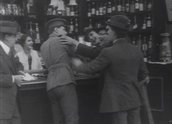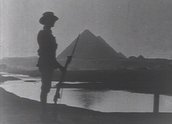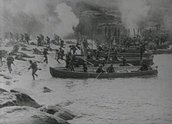



The Hero of the Dardanelles (1915)
Synopsis
Will Brown (Guy Hastings) enlists in the Australian Army, soon after the outbreak of the First World War. He puts away his sporting equipment, in favour of more serious duties. He joins hundreds of other men in a training camp at Liverpool, near Sydney. He urges his friends to join up and he manhandles a pacifist who disagrees with his display of a recruiting poster. Before embarking, he wins the promise of marriage from his sweetheart, Lily Branton (Loma Rossmore). Arriving in Egypt, he prepares for action, in the first wave ashore at Gallipoli.
The film was lost from this point until recently when Dr Daniel Reynaud, an Australian historian, discovered more footage. This shows the troops landing at Gallipoli on the morning of 25 April 1915, storming the cliffs and Turkish troops firing down from a machine gun emplacement. This was all reconstruction, restaged with real troops at Tamarama Bay, shortly after word reached Australia about the landings. Working with the National Film and Sound Archive, Dr Reynaud has done a partial reconstruction which shows the latter part of the film, in which Will falls into barehanded combat with a Turkish sniper. He drowns the Turk, is repatriated home wounded and eventually marries Lily. The film ended with a call to Australian men to do their duty and join up.
Curator’s notes
Even though only a third of the film survives, The Hero of the Dardanelles is an important and revealing fragment of our film heritage. The original film ran for about 59 minutes, but until recently, it was thought that only about 12 minutes survived. Recent research by historian Dr Daniel Reynaud has established that footage preserved in a 1928 silent film, The Spirit of Gallipoli, actually comes from this film. This shows the first re-creation of the landing at Gallipoli, which was filmed at Tamarama Bay, Sydney, shortly after the real landing took place on 25 April 1915. The re-enactment was done with soldiers from Liverpool army camp, west of Sydney. Dr Reynaud, working with the NFSA, has now returned this footage to its original place in The Hero of the Dardanelles, in a partial reconstruction. Most of the film is still missing, but we now have a more complete copy of what is Australia’s first feature film about Gallipoli.
It grew out of a recruitment film made by Alfred Rolfe a few weeks before the Gallipoli landings. None of that film survives, but Will They Never Come was made for Australasian Films – the conglomerate known as ‘The Combine’ – as a propaganda tool. It so impressed the Minister of Defence, Senator Pearce, that he was happy to assist Australasian’s next, more ambitious production The Hero of the Dardanelles with full access to troops and matériel.
The first press reports of the landings at Gallipoli had been published in early May 1915 in Australia, to immense excitement. The English war correspondent Ellis Ashmead-Bartlett had written in glowing terms of the valour and dash of the Australian and New Zealand troops on 25 April 1915. Australasian Films seized the moment to rush a feature film re-enactment into production. Troops in training at Liverpool were sent to storm the beach at Tamarama for Alfred Rolfe’s cameras. The film premiered at the Majestic Theatre in Melbourne – that city was still then the seat of the Commonwealth Government – on 17 July 1915, just 12 weeks after the actual landings. The film was a sensation, hailed for its realism, its patriotic spirit and its artistic merit. It was the first depiction of the action at Gallipoli in an age before television news. Even if it was fictional, it gave the Australian public a sense of what the landings looked like, as reported by Ashmead-Bartlett. No-one at that point questioned whether his dispatches were accurate or sober, or even reliable. Both his words and these pictures answered a public hunger for heroic figures and images.
What’s less obvious are the motives behind the Combine’s patriotic fervour. These were partly to do with their political survival. The Combine was a large and powerful virtual cartel, controlling most of the distribution and exhibition of films in Australia. It was controversial because of its strong links to the film industry in the US. When war broke out, there was a strong sentiment, especially amongst the ruling classes, that the country could no longer afford frivolous entertainments like movies and sport. The NSW police confiscated and destroyed more than one million feet of imported footage, including two films about the Napoleonic wars, lest the public support for the war be undermined by depictions of bloodshed. This was a dire threat to the Combine’s core business – which was not the production of Australian films. Filling the theatres with patrons, and giving a boost to recruitment, served the political ends of both the government and the Combine – at least for a brief period. (A few years later in the war, after the casualty lists had sunk in, films about the war became box-office poison).
The traces of all these political currents are still visible in the footage we have. The anti-sport idea explains the first scene, in which Will Brown puts away his cricket bat and puts on his uniform. The scene in the bar deals with a pacifist as a low and cowardly type. Will’s sweetheart accepts his ring, and promises to wait for his return, giving women a clear depiction of their duty to their own menfolk. Beyond these sometimes crude attempts at war mongering, the film remains valuable for its images of a real army camp and real soldiers, in training at Liverpool. There is a great irony in this, because the re-created landing sequences were being used as actuality within a decade of the film being made. People took them as actual depictions of the landings, rather than re-creation. The actual scenes are the ones of the army camp and soldiers in real training – learning how to shoot, dig trenches and march in time. We even get a good sighting of the rudimentary mess facilities at the time. This is documentary footage, in fact, rather than fiction. The brief scenes at the end, of Australian troops in Egypt, were taken from a series of Pathe newsreels.
The 1915 release of The Hero of the Dardanelles consisted of 4,000 feet of 35mm film and ran for 60 minutes at 18 frames-per-second. After partial reconstruction, what now survives runs for 21 minutes and 45 seconds.
- Overview
- Curator’s notes
- Video 4 clips
- Principal credits
- Find a copy
- Comments 3
- Add your review



